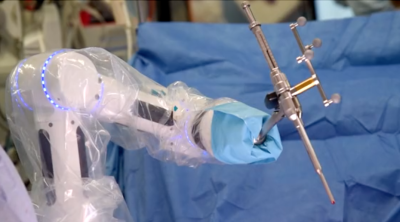Memorial Hermann Southwest Hospital is the first hospital in the nation to deploy an integrated robotic surgical suite that provides advanced 3D and 2D intraoperative imaging capabilities and an intuitive surgeon-controlled robotic arm that aims to increase reliability, consistency and surgical precision during minimally-invasive spine procedures.
 The hospital is in the Southwest Management District.
The hospital is in the Southwest Management District.
Joseph A. Cochran, M.D., an assistant professor in the Vivian L. Smith Department of Neurosurgery with McGovern Medical School at UTHealth Houston and a neurosurgeon affiliated with Memorial Hermann Southwest, utilized the technology recently while operating on Michael Ferguson, a 55-year-old who suffered a spine injury as a result of a motor vehicle collision. His official diagnosis was lumbar osteomyelitis with instability.
“Mr. Ferguson underwent data-enhanced, digital surgery – specifically a spinal fusion from L2 to the posterior pelvis – in the hospital’s new robotic surgical suite,” said Dr. Cochran. “Utilizing the imaging robot and robotic arm, Mr. Ferguson was able to undergo a less-invasive procedure with reduced trauma resulting in a quicker recovery.”
Imaging Robot
Digital spine surgery using the mobile imaging robot benefits both the clinical team and the patient. The system works in-sync with other devices in the operating room to enhance the surgical experience. Thanks to its mobile and circular design, the robot can be maneuvered around the patient, which allows the clinical team to perform precision imaging during surgery of very large boney structures like the pelvis, while also being able to narrow the radiation beam to treat very small structures like the cervical spine. Additionally, an independently moving imaging source and detector panels enable flexible patient positioning and specialized imaging, reducing the amount of radiation to the patient.
Robotic Arm
From the surgical side, the robotic arm acts as a reliable extra hand in the operating room. Controlled by the surgeon, the robot is moved and locked into place to guide movement during surgery. By having an extra software-driven hand, the surgeon can focus on all the surgical steps with both human hands.
“Our new robotic surgical suite is an exciting leap forward in our surgical capabilities at Memorial Hermann Southwest,” said Malisha Patel, senior vice president and CEO of Memorial Hermann Southwest and Memorial Hermann Sugar Land Hospital. “We are proud to be the first to break new ground with this new technology that can make every spine procedure safer and more precise.”
For more information on spine surgery at Memorial Hermann Southwest, visit www.memorialhermann.org/








